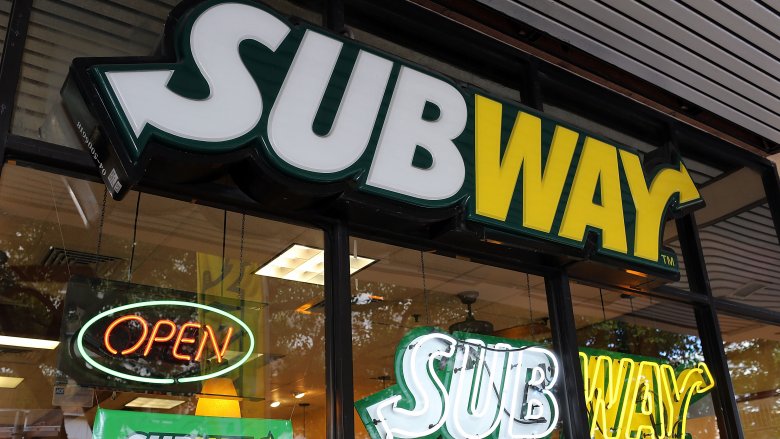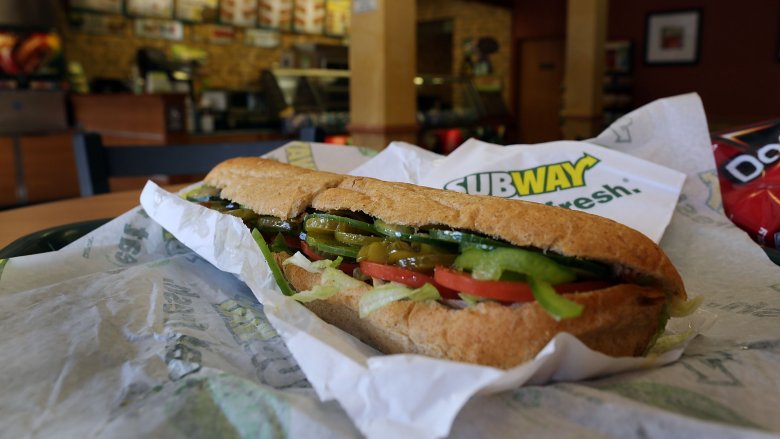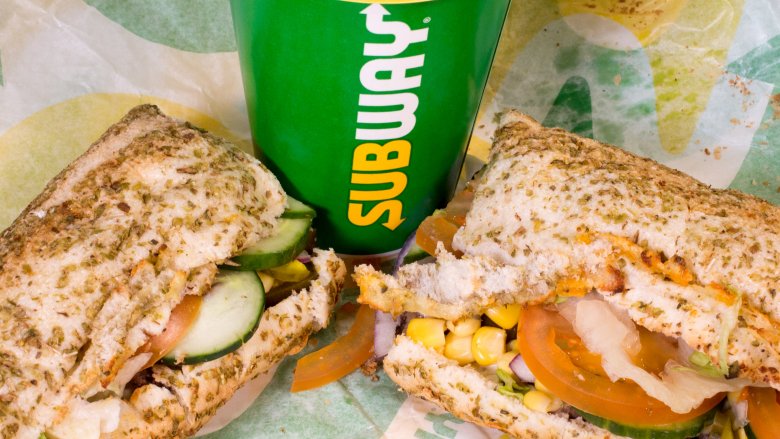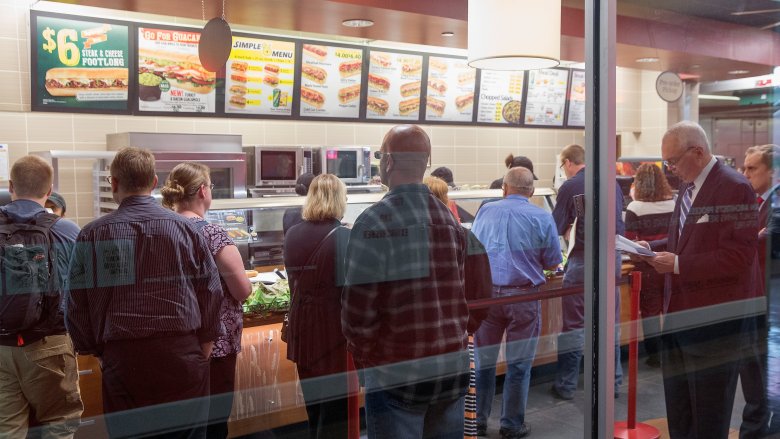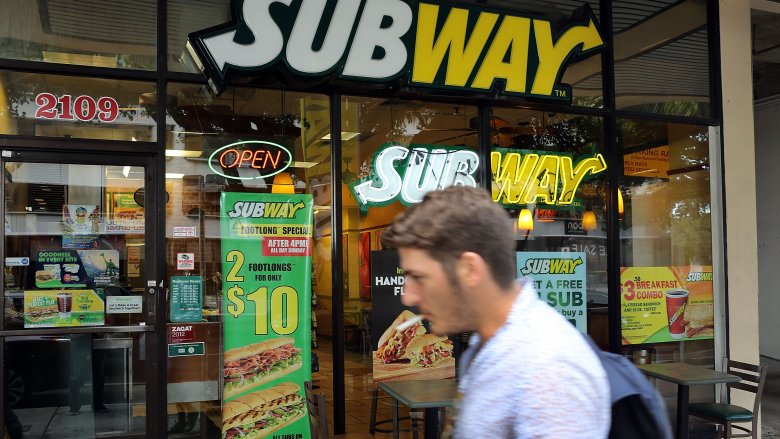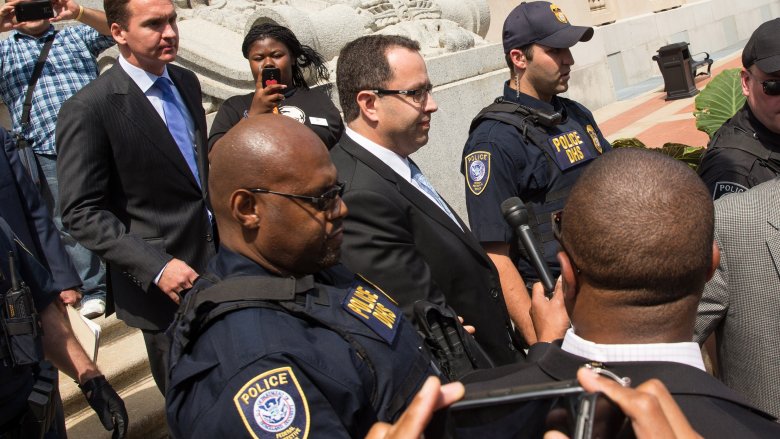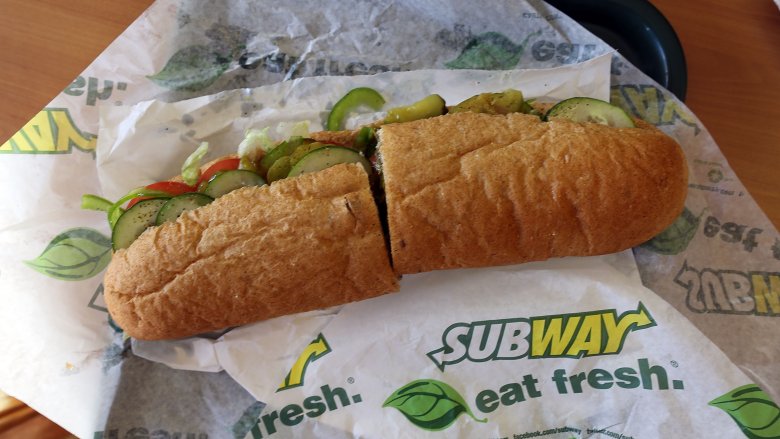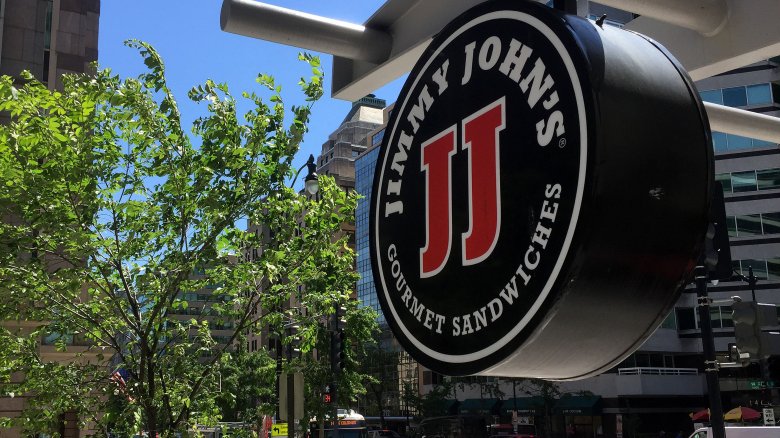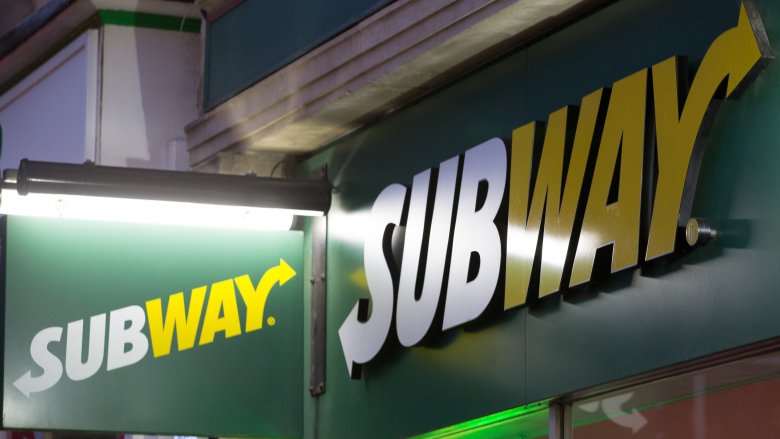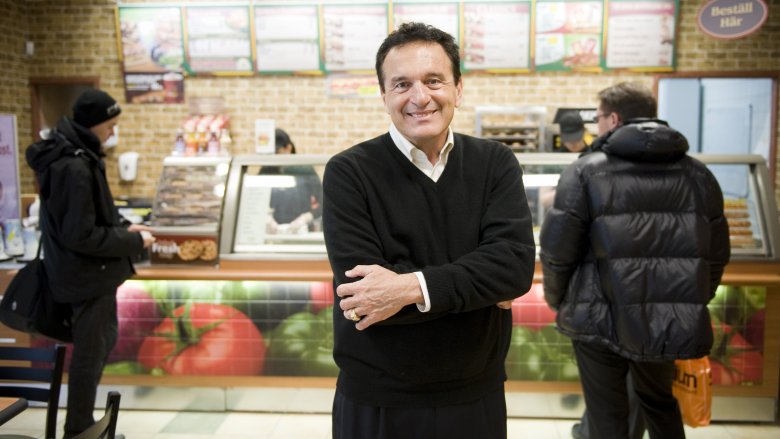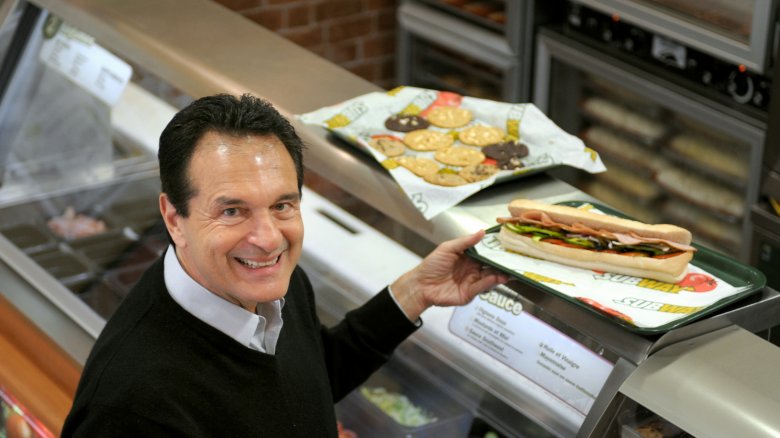The Real Reason Subway Is Disappearing Across The Country
When is the last time you stopped at a Subway? If it's been a while, you might not be surprised to learn that 2017 was not a good time for the chain that's been banking on their "Eat fresh" image to get customers through the door. It was only in late 2017 that franchisees found out — via company-wide memo — that business had fallen 25 percent since 2012, and stores were shuttering their doors. CNN reported that in 2016, Subway closed 359 locations and 2017 was even worse.
According to Business Insider, that year saw Subway closing another 909 stores across the country, and to put that in perspective, that accounts for about three percent of their domestic footprint. Closing that many stores isn't a decision that's taken lightly, so it's not entirely surprising there's a lot going on behind the scenes at Subway. Their problems are way more complicated than you might think, and range from supply problems to outright mutiny. So, why did your neighborhood Subway close?
Eat not-so-fresh should be the slogan
Subway built their brand on the idea of eating fresh, so if you've been to almost any location in recent years, you may have been surprised to find your sub toppings looking a little less than crispy, crunchy, and brightly-colored. According to Business Insider, it's not your imagination — and there's a business-breaking reason for that.
They spoke to a number of Subway franchisees and managers, and found most locations only get shipments of vegetables and produce once a week. Some busy locations get fresh produce in twice a week. While Subway stated they worked with around 100 suppliers and family farms to make sure all their locations had the freshest produce available, those on the front lines had other things to say. One Pennsylvania employee said, "A lot of the lettuce we receive is often near-expiry and is already turning brown even though the bags are vacuum sealed. The same goes for tomatoes. Often they are delivered and within a week are mushy and rotting."
Is it any wonder people might not go back after getting a sub described like that?
Those business-destroying scandals
One of the other things Business Insider says is to blame for Subway's continued struggles is scandals like the mystery-meat chicken findings of early 2017. That's when CBC Marketplace did DNA testing on six different fast food chicken items, including two Subway sandwiches: the Roasted Chicken Sandwich and the Sweet Onion Chicken Teriyaki.
The DNA tests showed Subway customers were getting 53 percent chicken in the oven-roasted samples, and 42 percent in the teriyaki samples. The rest was soy, and it's not surprising people were pretty outraged by the deception. Subway, on the other hand, says the tests were wrong, and claimed they allow for only one percent or less of soy to be included in their chicken products. (CBC later reported Subway sued over the results of the tests and the claims, saying the tests "lacked scientific rigour".) Denials notwithstanding, that's the sort of headline that can destroy a business's reputation.
Their loyalty plan had serious issues
Subway has obviously known their business has been steadily dropping off, and according to The Wise Marketer, they've been banking on improvements to the customer experience to help get the dollars flowing in the right direction again. Chief Executive Suzanne Greco has been championing things like digital menu boards and a mobile app, along with a customer loyalty program to help encourage repeat customers.
Franchise Times reported the Subway MyWay Rewards program finally launched in March 2018. The basics are that customers will earn four tokens for each dollar they spend, and when they hit 200 tokens, they'll get a $2 reward. (So, you'll be getting $2 in rewards for every $50 you spend.)
It's a pretty basic program, but it's also one that should have been in place years ago — it's been in the works, but with false starts linked to software difficulties and syncing each store's point of sale systems with the mobile apps, it's been slow in coming at a time when they needed it most.
Franchisees revolted
In December 2017, The New York Post got wind of more behind-the-scenes problems for Subway, and it was outright revolt from at least 400 of their franchise owners. It started when Subway corporate decided to temporarily bring back the $4.99 footlong promotion in hopes of revitalizing dwindling sales. Franchisees got together to petition against the two-month deal, saying it was absolutely the dumbest thing they'd ever heard, and was only going to hurt their already suffering bottom lines.
According to franchisees, cutting prices and discounting subs even more isn't going to make anything more profitable — just the opposite. While Subway corporate is talking about the solidarity they're seeing in their franchise, individual owners are saying something completely different. The franchisee letter sent to corporate read, in part: 'The national promotional focus over the past five years ... has decimated [us] and left many franchisees unprofitable and even insolvent," suggesting they're feeling something that's as far from solidarity as you can get.
Jared Fogle had a lasting impact
When Jared Fogle became the face of Subway, it seemed like a good idea. He was the perfect poster child for their healthy eating claims, and according to the Los Angeles Times, Subway profits rose 20 percent after his first commercials. Those profits dropped 10 percent after his contract expired in 2005, and you can just imagine what happened when he found himself in court on charges of distributing child pornography and traveling for sex with minors — charges he pleaded guilty to (via USA Today).
Sales and profits were already headed in a downward direction, and while it's impossible to say how many people decided to take their lunchtime business elsewhere after Fogle's arrest, it's safe to say it's definitely been a major factor for some people, even though Subway isn't actually guilty of anything but association in this case. According to University of Notre Dame professor of management James S. O'Rourke, Subway's public ending of their association with Fogle was the best thing they could have done — whether or not it was enough, who knows?
Their reliance on selling cheap foods
At the same time franchisees were revolting against the idea of the return of what was essentially the $5 footlong, the promotion's original creator spoke with Restaurant Business on why even he thought bringing it back was a bad idea.
Stuart Frankel was the owner-operator of a college campus-based Subway when he came up with the idea in 2003, but says Subway latched onto it and kept it for way too long. Even though it allowed them to grow and push some competitors out of the way, it did some major damage in the long run. He says customers became so used to the idea they could get a footlong sub for only $5 that they were hesitant to pay a full — and actually reasonable — price for subs.
"... once you keep pushing a low price point in the minds of the consumer, it's hard to sell sandwiches for what they're really worth," Frankel said. And selling them for what they're really worth would have helped Subway overcome the rising costs of doing business.
They have serious competition
Tracking the downfall of Subway is surprisingly complicated, and Restaurant Business says growing market competition is playing a huge part in taking business away from Subway.
When they first entered the restaurant market, they didn't have that much in the way of large-scale competitors. Quiznos was the other big kid on the block, and they made their name on their toasted subs. That was easy enough for Subway to adjust to — they just added the option for customers to have their rolls toasted — but other chains have flooded the market since. There's Jimmy John's, there's Firehouse Subs and Jersey Mike's, and there's Potbelly. At the same time Subway's profits have tanked, those four amassed some serious growth in 2016, accounting for $540 million combined... while Subway not only lost money, but started closing stores. Since Subway has been content with the status quo, that's allowed competitors to step up and start stomping them out.
There are too many franchisees
Subway is 100 percent franchised, and Business Insider said those closest to the inner workings of Subway say there's another problem going on here — too many franchisees. Mark Shearer is an attorney who has represented a number of franchise owners in lawsuits against Subway corporate, and he told BI, "This level of dysfunction has risen to the level of being flat-out evil."
Shearer says corporate is less concerned with giving their franchisees a chance to grow than they are with collecting the franchise fees. Stores open right on top of each other, corporate collects the fees, and the stores are left to scramble for business. Even worse, any complaints directed to corporate, about corporate, have led to what Shearer described as "Mafia-style" techniques employed to sabotage stores. Subway, of course, says none of that is true.
The chaotic leadership causes problems
By the beginning of 2018, Business Insider's deep dive into what was really going on behind the scenes at Subway found the fight over the $4.99 footlong was just the tip of the iceberg, and franchisees on the front lines of the business were seeing something much different from what corporate apparently was.
They say the schism between franchisees and corporate is so great that franchisees were at the point of calling for a change in leadership — specifically, they want to see a new CEO installed. Current CEO Suzanne Greco inherited the job when her brother, Subway founder Fred DeLuca (pictured), passed away in 2015 after a battle with leukemia. Greco stepped in after DeLuca named her as his successor (via Franchise Times), but franchisees told BI (on the condition they remained anonymous, since Subway corporate forbids franchisees from talking to media outlets) that they wanted a regime change. Part of the problem is a "yes-ma'am" sort of mentality, and there are claims that anyone with a viewpoint contrary to Greco's will be on the outs at corporate. Meanwhile, one franchisee summed up their situation like this: "I wish we had an advocate. This was my retirement, and now, well, it's over."
They're slow to change
As a whole, the nation is becoming more and more aware of what's in fast food. It seems like Subway, with their "Eat fresh" motto, should be on the top of the heap as far as healthy goes, but there's not much that's farther from the truth. Part of that is reflected in the fact they were surprisingly slow to make some serious changes to their menu and ingredients. While other chains — like Panera Bread and McDonald's — announced a long time ago they were going to phase out artificial ingredients, Subway only hopped on that bandwagon in 2015 (via Time).
Their menu has stayed the same for a long, long time, and the Huffington Post says the facts that they were slow to develop a breakfast menu, that they shy away from anything too experimental, and that they're seemingly unwilling to update for the 21st century, means that the 21st century has been moving on without them.
